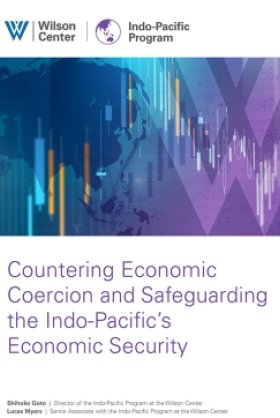"Keep on Saving": How Other Nations Forged Cultures of Thrift When America Didn't
Sheldon Garon, Fellow, Woodrow Wilson Center, and Dodge Professor of History and East Asian Studies, Princeton University
Overview
Sheldon Garon, Fellow, Woodrow Wilson Center, and Dodge Professor of History and East Asian Studies, Princeton University
After years of near-zero savings rates and growing household indebtedness, Americans are beginning to save again. But will they keep on saving? What might they learn from other countries that boast much higher savings rates? Americans have often explained relatively high savings rates in East Asia in terms of Asian cultural difference. However, at an event on March 16, organized by the Asia Program, and co-sponsored with the Program on America and the Global Economy, United States Studies, and European Studies, Sheldon Garon, Dodge Professor of History and East Asian Studies at Princeton University, pointed out that European nations have historically had high savings rates as well. Explanations which rely on assumptions about "Asian culture" are therefore unsatisfactory, and it is American difference from other industrialized nations that needs closer examination.
Why do industrialized nations elsewhere have higher rates of savings than the United States? Garon noted that institutions established in Europe and Asia have encouraged individual savings by accepting smaller deposits and offering higher rates of interest than commercial banks. In the late 18th and early 19th century, European philanthropists established savings banks, such as the German Sparkassen, as social institutions to encourage personal savings. Central governments in Europe also began to offer savings schemes administered by post offices, taking advantage of their existing network of branches. Finally, "elaborate centrally managed" school savings schemes "taught the habits and values of savings" and encouraged pupils to make small deposits each week in the classroom. East Asian governments, starting with Japan, imported many of these European concepts as part of their modernization processes.
However, an uneven population distribution, a federal system that discouraged centralized financial mobilization, and resistance from the private sector all acted against the establishment of savings banks in the United States. By 1909, only 10.2 percent of Americans held accounts in savings banks, compared to 22.5 percent in Italy (at the low end of the scale in Europe), and 55.2 percent in Switzerland. Legislation to establish an American postal savings system was introduced in Congress in 1873, but was resisted by commercial and regional interests until a watered-down version was passed in 1910. Even then, American postal savings offered unattractive interest rates and few rural branches in the South. The scheme was discontinued in 1966.
Garon noted that the war savings and bonds campaigns that are often depicted as uniquely American actually brought U.S. norms and institutions closer to European standards. The Second World War, for example, saw the proliferation of workplace and school savings schemes in the United States. However, the U.S. government did introduce one truly innovative savings-promotion policy before the war. The Federal Deposit Insurance Corporation (established in 1934) guaranteed deposits in private banks.
Savings campaigns during both world wars, moreover, engendered important social changes across the globe. Savings posters depicted women as "citizen savers" on the home front, while men fought on the battle front. Particularly in Japan, where wives had not previously been responsible for family finances, the role of women as "mistress of the household, mistress of finances" was a new development. These emerging gender norms increasingly defined Japanese family structures after the war. Women in several nations were also encouraged to act as state deputies, authorized to visit homes and pressure the inhabitants to save.
After the Second World War, European and Asian governments continued to promote savings to provide a ready source of public funds for reconstruction and the establishment of welfare states. With the American homeland unscathed by war, government policy in the United States, in contrast, focused on private consumption as the engine for postwar growth. Through mechanisms such as installment buying, consumers became accustomed to buying an array of durable goods on credit. Moreover, the government single-mindedly encouraged home ownership and housing credit as an alternative form of saving or asset-building. Despite Americans' reliance on consumer credit and home mortgages, household saving rates remained fairly high during the postwar decades.
From the 1980s, however, the deregulation of the credit card industry and the advent of home equity loans meant that individual consumers availed themselves of credit as never before. Predatory lending practices exacerbated indebtedness among credit card holders and those with home equity loans. After 2000, the appearance of subprime mortgages and the drop in real wages of working people further discouraged Americans from conventional saving, indeed leaving them with little margin to save. In addition, over the past 30 years, Americans have been persuaded to move from "saving to investment"—that is, to seek higher returns in the stock market and other investments carrying higher risk. While observing that collapsing housing prices, a volatile stock market, and economic uncertainty have prompted a modest increase in saving rates, Garon doubts whether Americans will "keep on saving" without a thorough reconsideration of the policies that so promoted consumption and cheap credit.
By Bryce Wakefield
Robert M. Hathaway, Director, Asia Program
Hosted By

Indo-Pacific Program
The Indo-Pacific Program promotes policy debate and intellectual discussions on US interests in the Asia-Pacific as well as political, economic, security, and social issues relating to the world’s most populous and economically dynamic region. Read more

History and Public Policy Program
The History and Public Policy Program makes public the primary source record of 20th and 21st century international history from repositories around the world, facilitates scholarship based on those records, and uses these materials to provide context for classroom, public, and policy debates on global affairs. Read more
Thank you for your interest in this event. Please send any feedback or questions to our Events staff.











